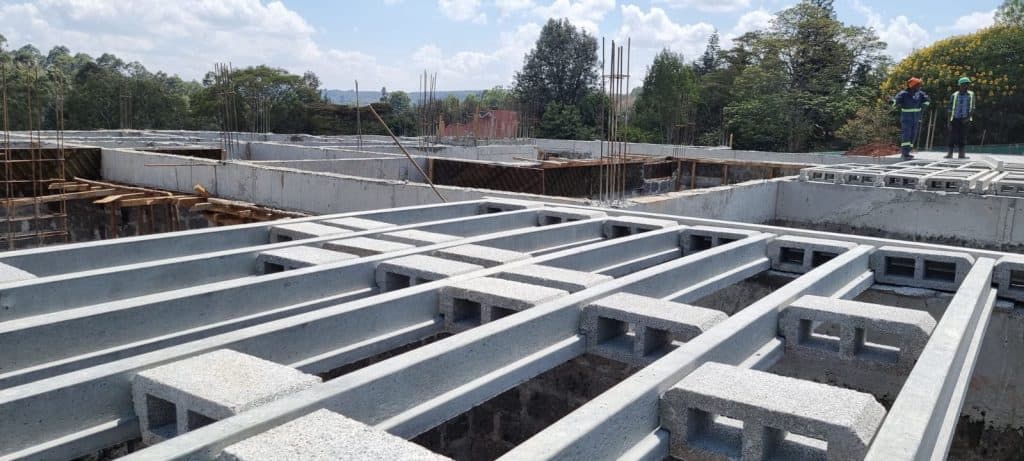Beam and Block Precast slab offer several benefits over conventional cast-in-place concrete slabs, especially during bad weather conditions. The Kenya Meteorological Department (Kenya MET) has issued a warning that the country may experience El Nino conditions in the coming months.
Have you ever wondered what causes the El Nino rains? El Nino is a phenomenon that occurs when the surface waters of the Pacific Ocean become warmer than usual, affecting the weather patterns around the world. El Nino rains are the result of this change in ocean temperature, which alters the atmospheric circulation and shifts the rainfall zones.
El Nino rains can have both positive and negative impacts on different regions, depending on their location and climate. For example, El Nino rains can bring relief to drought-stricken areas, but they can also cause floods, landslides, and crop failures in other places. In this blog post, we will explore some of the disadvantages of El Nino rains in construction and ways to mitigate them.
Disadvantages of El Nino rains in construction
– Increased risk of landslides and mudslides: El Nino rains can saturate the soil and increase the pressure on slopes and hillsides, leading to landslides and mudslides that can bury roads, bridges, buildings, and people. According to a study by the World Bank, El Nino events between 1997 and 2016 caused more than 23,000 deaths and $45 billion in damages worldwide, mostly due to landslides and floods.
– Delayed or canceled projects: El Nino rains can also affect the construction schedule and budget of projects, as workers may face difficulties in accessing sites, transporting materials, and operating machinery. Heavy rains can also damage equipment and materials or cause structural failures.
– Reduced quality and durability: El Nino rains can also compromise the quality and durability of construction projects, as excess moisture can affect the curing process of concrete, the strength of steel, and the performance of electrical systems. Moisture can also promote the growth of mold and fungi, which can pose health risks for workers and occupants.
– Increased environmental impacts: El Nino rains have a negative environmental impact on construction projects, as they can increase soil erosion, water pollution, sedimentation, and habitat loss. For instance, El Nino rains can wash away topsoil and nutrients from agricultural lands, reducing their productivity and increasing their vulnerability to droughts.
Ways to Mitigate the Effects
As we have seen, El Nino rains can pose significant challenges for construction projects. Therefore, it is important for construction managers and engineers to plan and adopt measures to mitigate the risks and impacts of El Nino rains on their projects. Some of these measures may include:
- Conducting a thorough risk assessment and contingency plan for each project
- Choosing appropriate materials and designs that can withstand moisture and water damage.
- Implementing drainage systems and erosion control measures to prevent flooding and landslides.
- Monitoring weather forecasts and adjusting work schedules accordingly.
- Ensuring adequate insurance coverage and emergency funds for potential losses
Advantages of precast beam and block during bad weather

If you are looking for a durable, economical, and easy-to-install flooring system for your building project, you might want to consider precast beam and block construction. This system consists of precast concrete beams and blocks that are placed on site to form a suspended floor slab. The beams and blocks are manufactured off-site in a controlled environment, ensuring high quality and consistency.
The system offers several benefits over conventional cast-in-place concrete slabs, especially during bad weather conditions. Here are some of the benefits of the precast beam and block construction during bad weather:
– Faster installation: Precast beam and block flooring system can be installed quickly and easily, without the need for extensive formwork, curing time or skilled labor. This reduces the construction time and the risk of delays due to weather interruptions. The system can also be installed in any season, as it is not affected by temperature or moisture variations.
– Improved performance: Precast beam and block flooring system provides a durable and resilient floor slab that can withstand heavy loads, impacts, vibrations and fire. The system also has improved acoustic and thermal properties, as the hollow blocks create air pockets that reduce sound transmission and heat loss. The system can also be combined with a cast-in-place concrete topping to create a composite slab that enhances the structural strength and stiffness of the floor.
– Reduced excavation: Precast beam and block flooring system can be used to create a suspended floor slab that reduces the need for excavation and soil removal. This is especially beneficial where the site conditions are unfavorable or where the environmental impact of excavation is high. The system also allows for greater flexibility in design, as it can accommodate different shapes and sizes of floor plans.
– Enhanced aesthetics: Precast beam and block flooring system can be customized to suit different architectural styles and preferences. The beams and blocks can be made in various colors, textures and finishes, creating a visually appealing floor surface. The system can also be integrated with other precast concrete elements, such as walls, columns and stairs, to create a cohesive and harmonious building structure.
Conclusion
Precast beam and block construction is a proven and reliable flooring system that offers many advantages over conventional cast-in-place concrete slabs. It is particularly suitable for intermediate floors in residential and commercial buildings, where sound reduction, fire resistance, and thermal mass are among its key benefits. If you are interested in learning more about precast beam and block construction, you can visit our website www.ecoconcrete.co.ke

